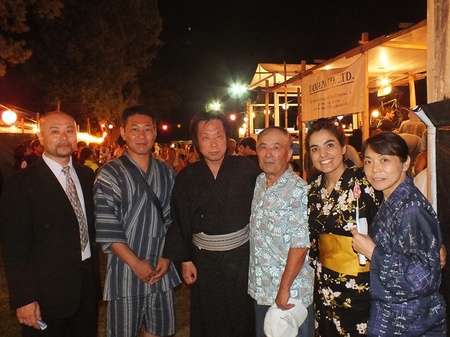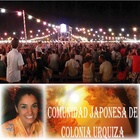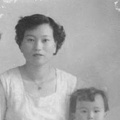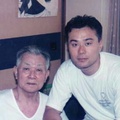This is a report that aims to comment on part of the repercussions of Bon Odori, which took place on January 10, 2015 in Colonia Urquiza Partido de La Plata. We will transcribe newspaper clippings that dealt with the topic on the same day and the next day - digitally and in newsprint - with interviews with attendees who came for the first time or who are regulars of the show.
Bon Odori 1 is a symbol of tradition, identity and integration, and has been celebrated in Colonia Urquiza every January, for one afternoon and evening for 16 years. It was declared of provincial and municipal interest 2 , thus granting visibility to the community within La Plata society and the entire province of Buenos Aires. Thanks to this recognition, the community builds cultural contact based on rapprochement and dialogue.
Next, we will rescue written material starting with the Speech of the President of the Bon Odori Commission and then from journalists, photographers and the impression of visitors in general.
The president of the Bon Odori Commission, Antonio Tsuru, addressed the crowd with the following words:
“To the authorities of the Municipality of La Plata, Ambassador Masashi Mizukami, Consul Kazuyuki Yoshimura, Secretary of Modernization and Economic Development Alejandra Sturzenegger, General Director of Social Economy and Productive Planning Hugo Heredia, Mr. Hiroyuki Takada of JICA, Correspondent of Asahi Shimbun from Brazil Tsuyoshi Tamura, press journalists and local and national radio stations, to the members of the La Plata Japanese Association, La Plata Japanese School, to the Japanese Associations of Colonia La Plata, Santa Mónica, El Pato, Tobu, La Plata, families, students, friends of the School and the general public, we welcome you to the 16th Bon Odori Festival of Colonia Urquiza.
As president of the Bon Odori Commission, I want to thank the presence of all of you who make the success of this event possible, and help continue with this show that has a very important meaning for the community, as it is a cultural event of recognition to our ancestors, and also to cover the expenses of our children's education at the La Plata Japanese School.
But I especially thank all the collaborators who have helped me in the organizational work, the teachers, the families who have dedicated their time to bring the festival to completion today.
Humbly, I share a feeling of deep gratitude for everyone's support and the trust they have placed in me, to be the visible image of this great event for one year. Thanks a lot."
The impact of the event in local newspapers :
The first was published digitally and at the time the festival was taking place, with a correspondent who sent the information directly to the editorial office.
Diario Hoy 01/10/15 - 8:00 p.m. (at: diariohoy.net )
Melchor Romero, Buenos Aires, Argentina. The geographical location would not say anything about the Japanese, if we only keep the name of this immense neighborhood of our city. But within the Romero region there is Colonia Urquiza. And families with oriental roots, precisely from Japan, live and dream there.
The “Bon Odori” is the annual celebration with which they delight visitors and with which their spirits relive stories related to their culture.
The XVI edition started in full sun, when at 7:50 p.m. the influx of the public began, with the dance of the three sensei teachers, who taught the step.
Ambito Financiero by Gonzalo Gossweiler (at: Ambito.com ).
The Japanese have countless festivals and colorful celebrations that come from ancient traditions. Far away from its archipelago, we only usually receive images of that culture that amalgamates the ancient and the modern with total naturalness. In Argentina, the Japanese community strives to maintain its identity and spread it with celebrations in which the door is opened to anyone who wants to attend, allowing us a glimpse of those colorful customs. Among them, one of the most notable is Bon Odori.
Bon Odori is a matsuri (festival) which derives from a religious rite, the Obon , which hundreds of years ago added the Odori (dance). There are several types and at different times of the year, but they all have music, dance and traditional foods in common. In our country it is carried out in areas with a large concentration of Nikkei (Japanese immigrants and their descendants) such as La Plata, Burzaco, José C. Paz and others.
In the town of Melchor Romero, La Plata, is the Colonia Urquiza, a refuge for a significant number of Japanese immigrants who settled in the 50s and 60s. There they founded the La Plata Japanese Association, which organized this past Saturday the 16th edition of his Bon Odori. The attendance, of several thousand, surprises each year due to its growing massiveness despite taking place in a semi-rural area.
Although the Nikkei are the protagonists, the bulk of the visitors do not belong to that community. Both groups mix and attend with their families, many of them dressed in yukatas , a type of summer kimono. There is never a shortage of cosplayers, young people who dress up as their favorite anime characters.
The La Plata property - larger than one hectare - was delimited on its perimeter with various stalls selling traditional souvenirs, food, drinks, imported items, traditional clothing, etc. In the center there was a yagura (tower) from which dozens of colored lanterns were hung that illuminated the entire space.
In the afternoon, people began to arrive, and every stand of Japanese products and crafts was covered with shoppers and onlookers. At the same time, various singers did their live performance and later the Buenos Aires Taiko group performed their percussion show with traditional drums. On that dance floor that surrounded the tower, the Bon Odori was launched and the experienced women in yukatas led the procession, marking the steps that the non-connoisseurs imitated as best as possible to the rhythm of the Japanese songs that are customary for these festivities.
Towards the evening, everyone looked for dinner and the most requested was homemade food: yakitori (chicken skewers), harumaki (dumplings), takoyaki (balls with octopus), sushi, onigiri (rice ball with some filling), noodles, etc. . There was no shortage of Japanese sweets such as manju, dorayaki, mochi and others. While some ate, others replaced the audience that danced around the tower in the succession of laps that lasted several hours.
Towards the end of the festival, the Japanese ambassador to Argentina, Masashi Mizukami, spoke to those present and was amazed by the massive attendance . Next, the fireworks - the hanabi - were displayed, lighting up the sky for about 10 minutes with a dazzling display.
Since 1999, the Bon Odori from La Plata has amazed visitors with the Japanese idiosyncrasy that is evident in the hard organization and dedication to the details that are seen, for example, in the division of tasks, in the food stalls and even in the systematic parking order.
Through their traditions, this festival and others like it, reaffirm the bond that unites the Japanese community with the country that sheltered it. There, native Japanese children and elderly people join in a murmur that mixes Spanish and Japanese. Bon Odori is a panoramic photo of a cultural exchange, a product of the historic immigrations that forged the country, introducing us to one of the most striking cultures in the world.
Grades:
1. Bon, it is a festive season during which the souls of ancestors are welcomed. It is the Buddhist tradition and practice of honoring the spirits of ancestors. Odori, means dance. Therefore, Bon is the day of the dead ancestors, and Bon Odori is the dance that accompanies and consoles the souls of those deceased.
2. The Bon Odori was declared of municipal and provincial interest since 2008, resolution 0391, by the Cultural Institute of the Province of Buenos Aires, as a heritage not only of the Japanese community that organizes it but of the entire La Plata community. and Buenos Aires.
© 2015 Irene Isabel Cafiero








